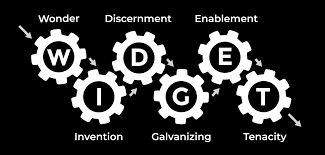Working Genius ProTip
March 2022
What’s the first thing that comes to mind when I say work? Maybe you picture time in the lobby or singing on stage, maybe it’s opening your laptop or time in meetings. It may even be a feeling like “Ugh!”, or “Yay!” (gosh we hope it’s yay!).
No matter what you picture when you think of work, the truth is that behind the work we do each day there is a natural process that not only drives how that work gets done, but also, and most importantly, the unique giftings we each bring to our work.
Patrick Lencioni, author and founder of the Table Group, captures all of these ideas about work in his new model Working Genius™. He says, “Far too many people in the world suffer needlessly because they don’t understand their personal areas of working genius. As a result, they don’t do the kind of work that gives them joy and energy…”. Working Genius helps teams stay healthy, move faster, and get more done. That’s why if you joined us for the March CreekHelp Academy with guest Beau Johnson from the Table Group, you heard an incredible unpack on Working Genius™ and the six types:

As a re-cap, or if you haven’t had a chance to take a look, consider how to make Working Genius a part of your everyday by:
Step 1
The first step to understanding these 6 types is to know your own and to know the model. Step 1 is taking the assessment. “It’s the fastest and simplest way to discover your natural gifts and thrive at work.” You’ll receive results that look like this:

It provides your top 2 geniuses, but then also categorizes the other 4 as either a Working Competency (I can do it, but it’s not where I thrive) or a Working Frustration (I can do it, but it doesn’t bring energy or joy). With results in hand, (and added to Rock so we can help each other thrive) take time to review the CreekHelp Academy, check out WorkingGenius.church, or listen to a few episodes of The Working Genius podcast.
Now this is when it gets fun!
Step 2
Consider the altitude of your gifting along with the project or team you are working on or with. The analogy of working genius is that it’s “like flying a plane”. Wonder starts at the highest altitude, asking big “I wonder if…” questions, while Tenacity is at the lowest altitude asking “What will it take to get this thing done?!”.

The primary key and value to keep in mind is that no one altitude is better than another. Each stage is critical. The altitude is more of a reflection of who is really needed when. So whether you lead a team or are participating with a team, it helps when you know what altitude the plane is flying so that you can:
- Understand what you bring and what your teammates bring to work – you will always bring your geniuses first. There’s nothing wrong with that, but self-awareness is key towards being #bettertogether
- Avoid altitude sickness, disruption and turbulence. This is the feeling we all get when a meeting or project bounces from one altitude to another, or out of order and we’re confused, frustrated or the work gets disrupted and progress is difficult
- As a leader, ensure all 6 phases of work are done. It increases the energy and joy of the team and increases the speed and effectiveness of the work. In addition, it will help you avoid leading only from your genius and instead invite others in.
Step 3
Go for it! And as you do:
Understanding the different giftings and why each stage matters. Notice how the gifts lend themselves to broader stages of work as shown below:

This can be particularly helpful if you know the gifts of the team and helps you see the bend each team member has towards either ideation, activation or implementation. Consider a team map of Working Genius (example from Table Group below):

Or look up your teammates profile and grab a lunch to talk about what you each bring and how it gives you energy and joy.
Name your meetings or ask what type of meeting this is. For example, are you in Galvanizing about an upcoming camp? Insure all of your team knows it. Just because someone doesn’t have galvanizing in their gifting doesn’t mean they shouldn’t be around the table – all perspectives are key, and inviting everyone to participate will help those who don’t have that genius focus on and appreciate what other geniuses bring.
Keep asking yourself, where are we in the project we’re doing today? Have we worked through all 6 phases? For example, “We’ve galvanized around this new project, it’s now time to help people see what they can do, we’re moving to enablement.” Also if you plan projects or work with teams, consider the timelines needed for the phases and avoid getting stuck in any one phase for too long. Lencioni says that about 20% of work is wonder and invention and the bulk of work (80%) is in the others.
At the heart of all of this – armed with the Working Genius model and the giftings of the team – the goal is that when we picture work, we’re filled with purpose, joy and energy, confident that God is using what we do to make an eternal difference. It’s a key step on the life-changing adventure, and using the tools of Working Genius can be one of the ways to help us make that difference together.

